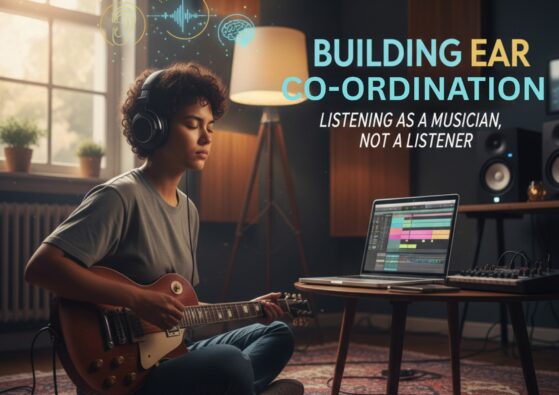Improving Your Guitar Soloing Skills
Guitar soloing is a captivating and essential skill for any guitarist, allowing you to express yourself and showcase your musicality. Whether you’re jamming with friends, performing on stage, or recording your own music, the ability to create memorable solos can elevate your playing to new heights. In this blog, we will explore key techniques and strategies to help you improve your guitar soloing skills.
What is Guitar Soloing?
At its core, guitar soloing is the art of improvising melodies over chord progressions. Unlike playing rhythm guitar, where you focus on providing the harmonic foundation, soloing allows you to express your musical ideas and emotions freely. A great solo can evoke feelings, tell a story, and engage your audience.
The Importance of Expression
Every guitarist has a unique voice, and soloing is your opportunity to let that voice shine. The beauty of soloing lies in its improvisational nature—there are no strict rules, just guidelines that can help you create compelling music. As you become more comfortable with the fundamentals, you’ll find your own style and voice within your solos.
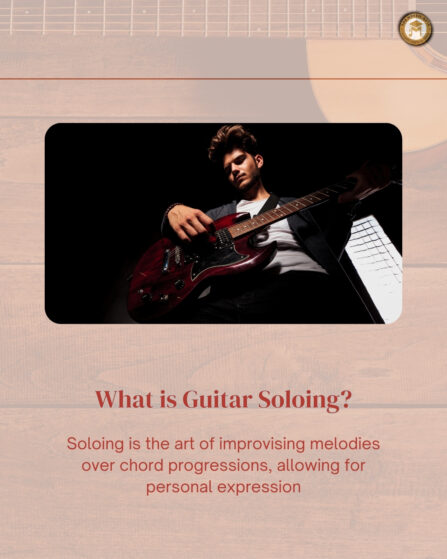
Learn Your Scales
To build a strong foundation for soloing, it’s crucial to familiarize yourself with various scales. The three fundamental scales every guitarist should know are:
- Major Scales: These scales have a bright, happy sound and are used in a variety of musical genres.
- Minor Scales: These scales evoke a more somber, emotional tone, making them perfect for expressing deeper feelings.
- Pentatonic Scales: These five-note scales are widely used in rock, blues, and jazz, providing a versatile framework for improvisation.
Scale Practice
Start by practicing each scale in different positions on the fretboard. This will not only improve your finger dexterity but also help you understand the layout of notes on the guitar. Use a metronome to keep your timing consistent, and gradually increase the tempo as you become more comfortable with the scales.
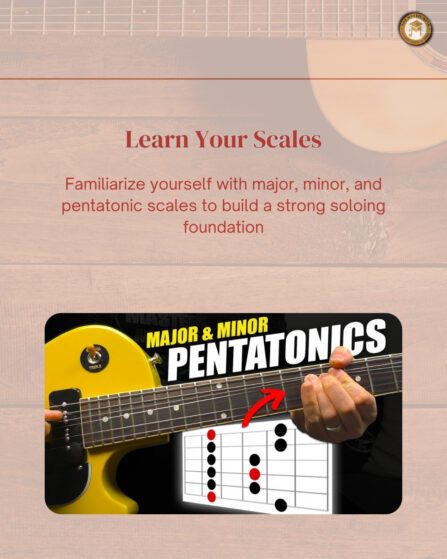
Practice Melodic Phrasing
Just like a singer has a lyrical phrase, your guitar solos should have a musical phrase structure with a clear beginning, middle, and end. This approach makes your solos more relatable and engaging. Here are some tips to help you develop melodic phrasing:
- Start Simple: Begin with simple melodies that emphasize the chord tones. Use quarter notes and eighth notes to create a steady rhythm.
- Build Tension: Incorporate techniques such as slides, bends, or legato to add emotional weight to your phrases.
- Resolve: Make sure your phrases lead to a satisfying conclusion, similar to how a sentence ends. This can be achieved by landing on a root note or a chord tone.
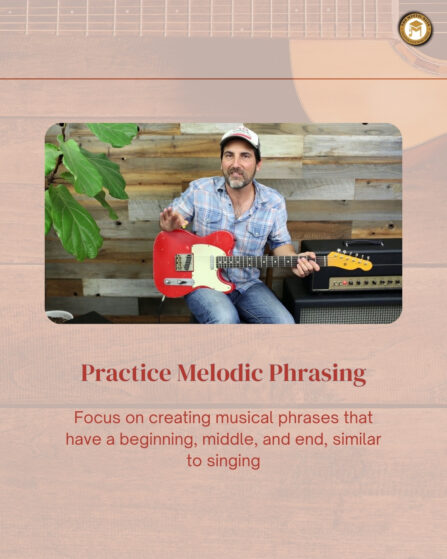
Incorporate Bends and Slides
Adding techniques like string bending and sliding can enhance the expressiveness of your solos. These techniques allow you to emulate the human voice, making your guitar sound more dynamic and emotional.
String Bending
Bending a note allows you to raise its pitch, creating a distinctive sound. Practice bending notes to specific pitches, and combine this technique with other notes in your solo for added flavor.
Sliding
Sliding from one note to another gives your playing a smooth, connected feel. Experiment with sliding into and out of notes to create fluid melodies that capture your audience’s attention.
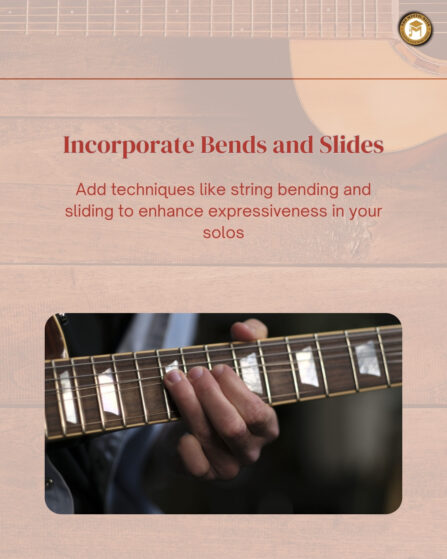
Use Arpeggios
Arpeggios are broken chords that can outline the harmonic structure of a piece. They add melodic interest to your solos and can be used to create tension and resolution. Here’s how to effectively incorporate arpeggios:
- Outline Chords: Use arpeggios to emphasize the chords being played. For example, if the progression is C-G-Am-F, play arpeggios based on each chord’s notes.
- Connect with Scales: Combine arpeggios with scales to create more complex and engaging solos. This will give you a wider range of notes to work with, enhancing your melodic possibilities.
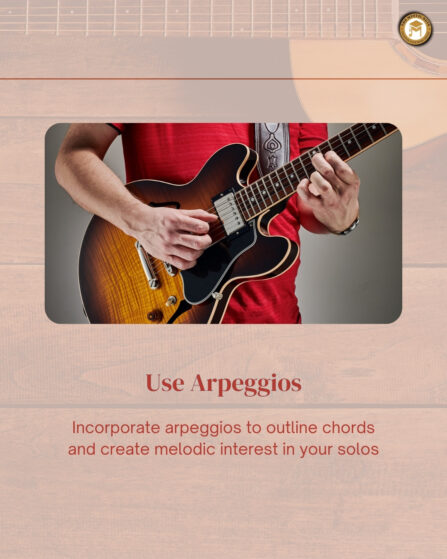
Listen and Transcribe Solos
One of the best ways to improve your soloing skills is to study the work of your favorite guitarists. Listening to and transcribing their solos can provide valuable insights into their techniques, phrasing, and styles.
Transcription Tips
- Choose a Solo: Select a solo that resonates with you and is appropriate for your skill level.
- Break it Down: Listen to the solo in small sections. Focus on one phrase at a time, and try to replicate it on your guitar.
- Analyze: Pay attention to the techniques used, such as bends, slides, and rhythmic patterns. Understanding how these elements work together will enhance your own playing.

Experiment with Different Rhythms
Rhythm is a crucial aspect of soloing that can dramatically alter the feel of your music. By varying your rhythmic patterns, you can create unique and engaging solos. Here are a few ways to experiment with rhythm:
- Syncopation: Use off-beat notes to create unexpected accents and tension.
- Triplets: Incorporate triplet rhythms to add a swinging feel to your solos.
- Silence: Don’t be afraid to use pauses in your playing. Silence can be just as powerful as notes, allowing your solos to breathe and create anticipation.

Jam with Other Musicians
One of the most rewarding ways to practice soloing is by jamming with other musicians. Collaborating in a live setting helps you develop your improvisation skills and gain confidence in your playing.
Benefits of Jamming
- Real-Time Feedback: Playing with others allows you to receive immediate feedback on your solos, helping you refine your skills.
- Adaptability: Jamming teaches you to adapt your playing to different styles and genres, enhancing your versatility as a guitarist.
- Building Musical Connections: Collaborating with other musicians fosters creativity and can lead to new ideas and inspirations for your solos.
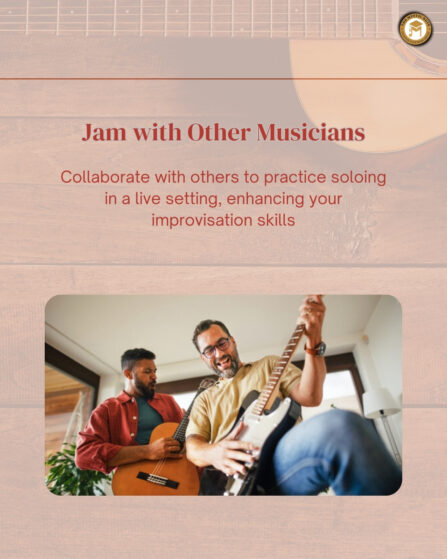
Conclusion
Improving your guitar soloing skills is a journey that requires practice, patience, and passion. By focusing on the essential techniques outlined in this blog—learning scales, practicing melodic phrasing, incorporating bends and slides, using arpeggios, listening to solos, experimenting with rhythms, and jamming with other musicians—you’ll be well on your way to becoming a more confident and expressive soloist. Master Electric Guitar from basic to advanced with our Electric Guitar Lessons Online, and take your soloing skills to the next level. Remember, every great guitarist started somewhere, so embrace the process and enjoy making music! Happy playing!






